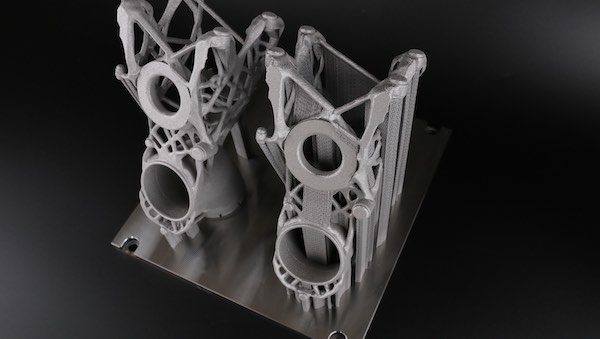EOS Aims for Support-Free Metal AM
New Smart Fusion monitoring software delivers real-time intelligence for heat management, reducing the need for supports and minimizing material usage.

EOS Smart Fusion software eliminates the need for most support structures while minimizing material use. Image Courtesy of EOS
Latest News
April 12, 2023
Supports are a double-edged sword when it comes to metal AM: They help ensure much-needed structural integrity for parts, yet complicate print jobs due to their reliance on significant post-processing steps.
EOS is tackling that problem straight on for its line of laser powder bed fusion (LPBF) metal 3D printers. The company launched its Smart Fusion software, designed to eliminate the need for most support structures, minimize material use, and reduce post-processing requirements, resulting in lower cost-per-part (CPP) ratios for metal AM applications.
The software measures the amount of laser power (energy) absorbed by the powder bed via a special high-resolution camera, which monitors each layer’s meltpool emissions. The proprietary technology collects data and feeds it back to the laser where adjustments are made in real-time to deliver homogeneous energy distribution across the entire build platform.
By auto-adjusting the laser power and detecting build problems proactively, Smart Fusion reduces stress in parts, avoids overheating metal, and decreases the chance of movement in undesired directions. The end result is that users no longer waste time and resources experimenting with “trial and error” AM. There is also no significant time added to the build time—EOS officials claim Smart Fusion performs its monitoring and laser adjustment work anywhere from 2x to 5x faster than competitors in the metal AM market.
Smart Fusion pairs with EOS’ existing monitoring solutions, adding more advanced algorithms to monitor the build layer-by-layer and resulting in more homogeneous parts. The EOS metal AM workflows starts with EOSPRINT, which prepares the data that is sent to the 3D printer, with EOSTATE and Exposure Optical Tomography (OT) used to measure the heat distribution. Smart Fusion picks up the process, via a controller that determines the laser power correction factors and makes the requisite adjustments on-the-fly in the ensuing layer. “These steps are repeated for each layer, reducing the iterations needed to get a part down to one and reducing support structures to a minimum,” says Micro Schöpf, EOS product line manager of software.
“Smart Fusion is another important breakthrough for metal AM, especially for those organizations with highly-engineered applications such as energy, space tech, mobility, and aerospace,” Schöpf says. When compared with comparable solutions in the market, the EOS package offers faster build times and doesn’t require an expert to make sure it works, he added.
This video provides a basic tutorial on EOS’ monitoring solutions.
More EOS Coverage
Subscribe to our FREE magazine, FREE email newsletters or both!
Latest News
About the Author
Beth Stackpole is a contributing editor to Digital Engineering. Send e-mail about this article to [email protected].
Follow DE





